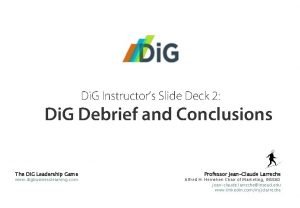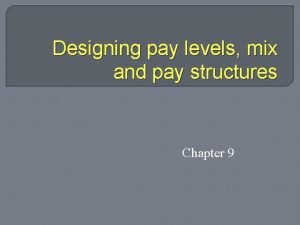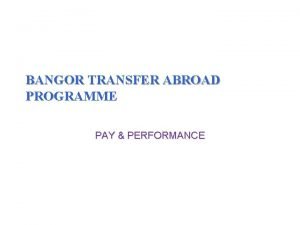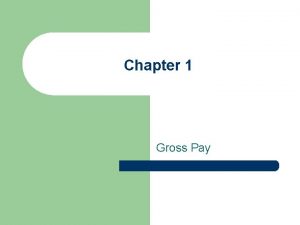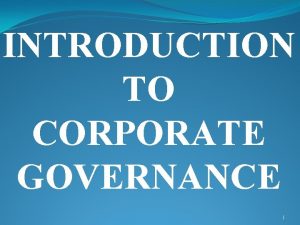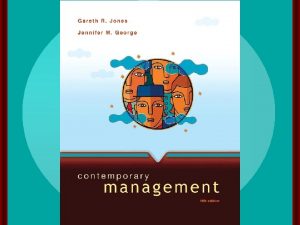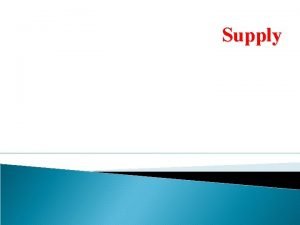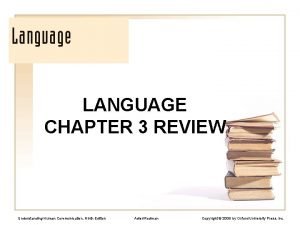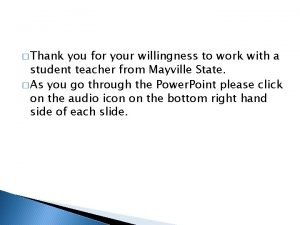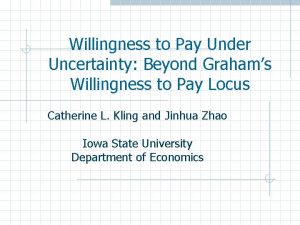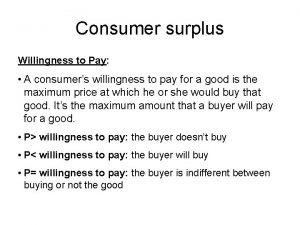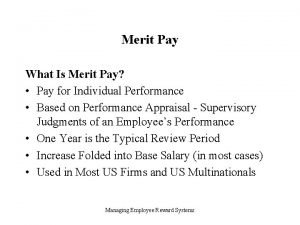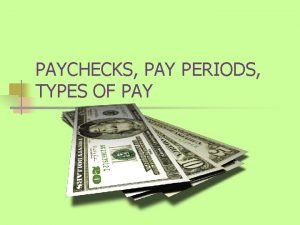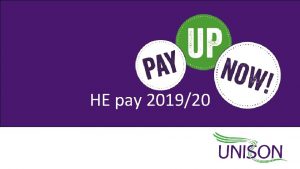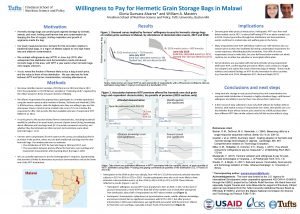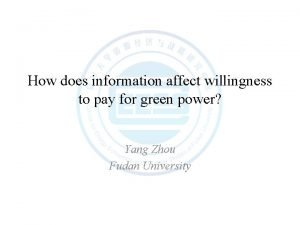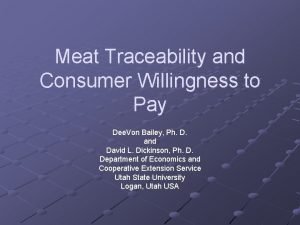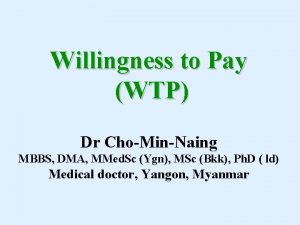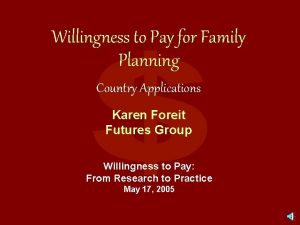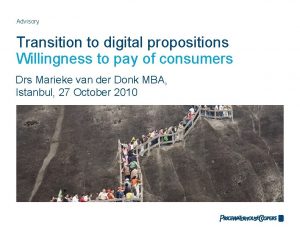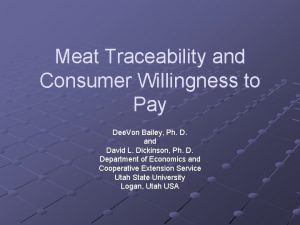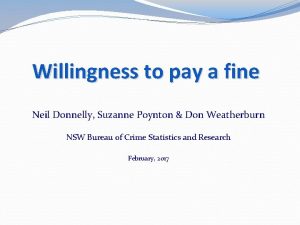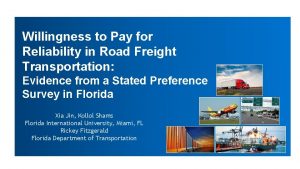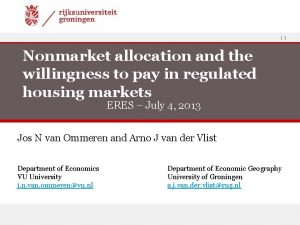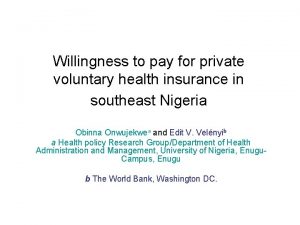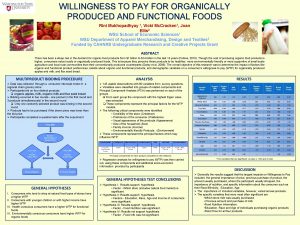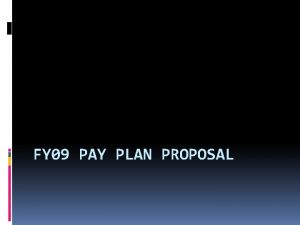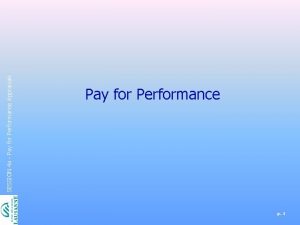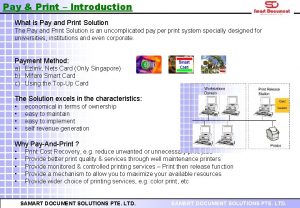A research to the Willingness To Pay for









































- Slides: 41

A research to the ‘Willingness To Pay’ for different attributes in sustainable renovations Student: Derek van den Berg First mentor: Anke van Hal Second mentor: Clarine van oel External examiner: Peter Koorstra

Table of Contents Introduction Objectives Research Questions Sub Question 1 Sub Question 2 Methodology Attributes Vignettes Results Conclusion & Discussion (answering sub question 3&4 & main research question) Recommendations for further research 2/41

Introduction – Global sustainability challenge Global: depletion of natural resources & rising CO 2 levels rising temperature, rising sea levels deterioration of earth’s ecosystems (NASA, 2015) EU/NL: measures to cut emission of greenhouse gasses: 2020: greenhouse emissions cut by 20% 2030: greenhouse emissions cut by 43% 2020: Generation of 20% sustainable energy (European Commission, 2015) 3/41

Introduction – Role of the building sector 4/41

Introduction – Demolition & Reconstruction? Demolition & Reconstruction: Not an option! • • • Creates demolition waste with ecological consequences Waterbed effect: social problems when moving groups of people Increasing volume of capital loss (van der Flier & Thomsen, 2010) • • 5/41 Demolition & reconstruction requires a lot of resources: energy, money, people, time, materials, etc Logistic Problem: temporary housing Emotional bond of families with their home is eradicated Annual replacement too low to replace all unsustainable dwellings (van Nuenen, 2008)

Introduction - Different Financial Playfield Influence economic crisis (>2008) • Cut in stimulus programs for sustainable solutions (Geels, 2013) • Overall fragile economic situation: reduced confidence among homeowners • Changed fiscal policies: The Netherlands • • • 6/41 MIA: allows contractors to deduct 36% of the investment costs for a sustainable asset from the company’s profit (Belastingdienst, 2015) VAMIL: Enables contractors to deduct up to 75% of the total investment costs (Belastingdienst, 2015) Changed VAT for residents: Only 6% has to be paid over the labour of a sustainable renovation in comparison to the usual 21%

Introduction - Different Financial Playfield “Plenty of money available in the private sector, however confidence needs to be restored” (Zenghelis, 2012) 7/41

Introduction - Target Group The distribution of the target group for this research (own work): based on data of “The Choice Marktonderzoek” (2014) 8/41

Introduction - Target Group Dispersion of row houses over NW Europe (Bellstedt, 2014) 9/41

Introduction – Financial Challenges Target Group • A lot of mortgages still ‘under water’ • Average sustainable renovation too expensive: cheapest solution costs € 60. 000 (Stroomversnelling, 2014), while average homeowners own € 45. 000 (Kakerbeeke & Reijerman, 2015) • There are no performance guarantees (Dekker, 2014; van Klauw, 2014) • Financial benefits such as ‘increase in market value not clear’ 10/41

Introduction – Financial Benefits Target Group • ‘Hidden environmental costs’ (van Hal, 2006) • Extended lifespan • Protection against price swings in energy • Increase in market value due to overall quality increase 11/41

Introduction – Current Payback Model Current payback model: using the savings on the energy bill to pay back the investment Private Homeowners on average have an energy bill of € 160 per month Problem with the current payback model: it takes too much time to pay back It would take 20 -30 years to pay back the investment • • As homeowners change on average 11 years of house, 20 -30 years is too long This period can be reduced, if other financial benefits are brought into the equation: • • • 12/41 Cheaper tailor-made sustainable renovation package Less maintenance Market value increase

Introduction – Case Study to Market Value Increase Most important data: increase in market value as percentage of total investment costs Aweg Current market value Current energy bill Investment needed Future energy bill Energy reduction Energy savings over 30 years Increase in market value as percentage of total investment costs Increase in market value as a percentage of the 30 year energy savings € 250. 000 € 122 per month € 50. 000 € 80 per month 34% € 10. 000 € 19. 000 38% 190% Vstraat (Prêt-à-Loger) Current market value € 187. 500 Current energy bill Investment needed Future energy bill Energy reduction Energy savings over 30 years Increase in market value as percentage of total investment costs Increase in market value as a percentage of the 30 year energy savings € 175 per month € 125. 000 € 0 per month 100% € 47. 000 € 37. 000 30% 75% Conclusion: there is willingness to pay for quality which results in a higher market value 13/41

Introduction – Quality There seems to exist a correlation between ‘Quality’ & ‘Willingness to Pay’ Which factors (attributes) in sustainable renovations are responsible for this higher WTP? Can we define a set of attributes and research homeowners’ quality perception of these attributes and thus assess their WTP? 14/41

Introduction – Problem Statement • Problem with the post-war >1979 privately owned row houses: cramped, unsustainable and uncomfortable: sustainable renovations needed • Sustainable renovations often financially unattractive for private homeowners • There are certain unexplored financial benefits such as: • • Cheaper tailor-made sustainable renovation package based on preferences Taking into account market value increase due to increase in quality • To clarify these benefits, the homeowner’s perception towards quality has to be measured • This can be done by decomposing a sustainable renovation in different attributes and assessing the WTP of homeowners towards these attributes 15/41

Objectives Main objective: Clarifying the perceived quality of the different attributes in sustainable renovations and the willingness to pay of the homeowners for these attributes. Subgoal: To discover the perception of private homeowners of the Dutch post-war row housing stock towards quality in sustainable renovations. Subgoal: To discover the willingness to pay of private homeowners of the Dutch post-war row housing stock towards certain attributes which can be included in such a sustainable renovation (e. g. a glasshouse, solar tubes or a green roof). Subgoal: Identifying an ‘ideal package’ containing all the preferred attributes by homeowners and calculating the costs of such a package. 16/41

Research Questions Main Research Question: “To which extent do different attributes in sustainable renovations of the post-war (<1979) terraced-housing stock affect the willingness to pay for private homeowners? ” Theoretical (sub) research questions: 1: “Which factors affect the decision making process of people”? 2: “How do people perceive quality”? Practical (sub) research questions: 3: “Which attributes of the sustainable renovations of Prêt-à-Loger and BAM generate the highest willingness to pay among private homeowners? ” 4 “What kind of sustainable renovation package would be preferred and how much is the willingness to pay for these attributes combined? ” 17/41

Research Design 18/41

Sub Question 1 “Which factors affect the decision making process of people”? Described by: Tiemeijer et al. Kahneman Klucharev & Smidts Etc. The factors that affect decision making processes falling under the affective system (own work) 19/41

Sub Question 2 “How do people perceive quality? ” Interesting findings literature: • • van Eck (2008) found that homeowners value quality much higher than energy savings in renovations. people tend to assign a lot of value to facades that contain decoration and details (Faro Architects, 2014; van den Berkhof, 2008) Conclusion: certain attributes are more preferred than others A research method is needed that enables us to combine the deployment of intrinsic and extrinsic attributes to determine the perceived quality and the willingness to pay 20/41

Conceptual Model 21/41

Methodology - Choosing research method Requirements Research Method: • Understandable for people >18 years • Research method should employ visualizations to provoke unconscious decision making processes • Designed in such a way that it allows to easily expand research population • Should enable researcher to resesarch relation between preference for quality and willigness to pay 22/41

Methodology - Choosing research method Different possibilities: 23/41

Discrete Choice Method - Why? • It is an appropriate method to assess design aspects • A complex research question can be simplified for the participants • Participants base their choice on what they see in the vignettes: miscommunication avoided (Zeisel, 2006) • Answering the questions is easy • The method allows the researcher to define general statements about the results (van den Berkhof, 2008) • It is possible to provide an optimal variance of attributes to the respondents (Mangham et al. , 2008) 24/41

Attributes • Based on renovation models of Prêt-à-Loger & BAM: • Use amount of attributes that is still calculable (Mangham et al. , 2008): 7± 2 attributes • Assigning attribute levels to the attributes. Every attribute that will be used, consists at least of two levels • Choice between: full factorial, a fractional factorial profile or a partial profile (Kuhfeld, 2010): partial profile chosen • Partial Profile: Many attributes, but not all of them are allowed to vary at a time (Kuhfeld, 2010). Through an algorithm, the amount of vignettes is be optimized. 25/41

Vignettes Requirements attributes: 1: Does the attribute increase energy efficiency? 2: Does the attribute increase comfort? 3: Is it possible to visualize the attribute in an image? Question 1 and 3 decisive. Price=exception Attribute Increase in energy Increase in comfort efficiency Yes Yes No Yes Yes New North façade New South façade North Roof PV Panels Solatube New kitchen Glasshouse Mechanical ventilation with HRS and PCM Box Floor/Wall heating Yes Ground floor Yes window New bathroom No Price 26/41 No Possible to visualize 3 D Yes Yes but difficult Yes Yes Yes No No

Final attributes for vignettes Final choice for attributes and levels: 27/41 Attribute North Façade South Façade North Roof PV Panels (South roof) New Kitchen Glasshouse Ventilation and cooling system Level 1 Old Vegetation PV Panels New closed kitchen Glasshouse Mechanical Ventilation with Heat Recovery System and PCM Box Level 2 Prêt-à-Loger Roof tiles No PV panels New open kitchen No Glasshouse Mechanical Ventilation with Heat Recovery System Heating Window Ground Floor Radiator Floor/Wall heating New window frame consisting of one window consisting of multiple windows (that can be opened) Price Costprice + 5% Costprice + 10% Level 3 BAM - Costprice + 15%

Visualization of the attributes: example 28/41

Visualization of the attributes: example 29/41

Visualization of the attributes: example 30/41

Practical Research Steps Step 1: Defining list of 100 vignettes (Excel) Step 2: Creating 3 D model in Sketch-up Step 3: Importing 3 D model in Lumion and rendering the vignettes Step 4: Creating movies of renders with windows moviemaker Step 5: Integrating Vignettes into questionnaire in Collector Step 6: Publishing questionnaire with vignettes through the VEH Step 7: Importing results into SPSS and coding then Step 8: Conducting analysis over coded results in SAS 31/41

Results Analysis of Maximum Likelihood Estimates 32/41 Parameter DF Standard Error 0. 10588 Chi-Square Pr > Chi. Sq 1 Parameter Estimate 0. 14081 Label 0. 1836 Hazard Ratio 1. 151 Sola. Tube 1. 7686 Roof. Vegetation 1 0. 53965 0. 21726 6. 1697 0. 0130 1. 715 Vegetation PVPV PCMPCM_MV 1 1 0. 39864 0. 21891 0. 22321 0. 09911 3. 1895 4. 8790 0. 0741 0. 0272 1. 490 1. 245 PV PCM-MV Heating. FWHeating 1 0. 04544 0. 10225 0. 1975 0. 6568 1. 046 FWHeating Window. Multiple 1 -0. 04045 0. 10103 0. 1603 0. 6889 0. 960 Multiple Kitchen. Open 1 0. 32460 0. 10325 9. 8832 0. 0017 1. 383 Open Glass. House. Glass. Ho use 1 -0. 19641 0. 11355 2. 9917 0. 0837 0. 822 Glass. House North. Fac. BAM 1 0. 04081 0. 10980 0. 1381 0. 7102 1. 042 BAM North. Fac. PAL 1 0. 19872 0. 11400 3. 0387 0. 0813 1. 220 PAL South. Fac. BAM 1 -0. 12201 0. 11161 1. 1950 0. 2743 0. 885 BAM South. Fac. PAL 1 -0. 14350 0. 11721 1. 4990 0. 2208 0. 866 PAL Price. Level. Plus 10 1 0. 03215 0. 24968 0. 0166 0. 8975 1. 033 Plus 10 Price. Level. Plus 15 1 0. 79262 0. 27301 8. 4289 0. 0037 2. 209 Plus 15 Roof. Vegetation. Pric e. L 1 -0. 87942 0. 35780 6. 0409 0. 0140 0. 415 Vegetation * Plus 10 Roof. Vegetation. Pric e. L 1 -1. 08025 0. 33378 10. 4745 0. 0012 0. 340 Vegetation * Plus 15 PVPVPrice. Level. Plus 10 1 -0. 01160 0. 38306 0. 0009 0. 9758 0. 988 PV * Plus 10 PVPVPrice. Level. Plus 15 1 -1. 06330 0. 36280 8. 5895 0. 0034 0. 345 PV * Plus 15 Sola. Tube

Discussion & Conclusion – Sub Question 3 Which attributes of the sustainable renovations of Prêt-à-Loger and BAM generate the highest willingness to pay among private homeowners? 33/41

Discussion & Conclusion – Sub Question 4 “What kind of sustainable renovation package would be preferred and how much is the willingness to pay for these attributes combined? ” Average favourite set of parameters Solatube No solatube - Green roof North Roof tiles North - PV Panels roof South Roof tiles roof South - MV with HRS & PCM MV with HRS - Floor/Wall heating Radiator - Window (one) Window (multiple) - New kitchen open New kitchen closed - Glasshouse No glasshouse - North façade old North façade PAL North façade BAM South façade old South façade PAL South façade BAM 34/41

Discussion & Conclusion – Sub Question 4 “What kind of sustainable renovation package would be preferred and how much is the willingness to pay for these attributes combined? ” How does that look like? How much would that cost? Favourite set of parameters No solatube Green roof PV panels South MV with HRS & PCM Heating (radiator) Window (one) New kitchen (open) No glasshouse North Facade PAL South Facade Old Cost price € 0, 00 € 4. 200, 00 € 7. 600, 00 € 10. 260, 00 € 811, 25 € 750, 00 € 8. 000, 00 € 7. 530, 00 € 0, 00 Total € 39. 151, 25 35/41 Price level 105, 00% 105, 00% 115, 00% 105, 00% WTP € 0, 00 € 4. 410, 00 € 7. 980, 00 € 10. 773, 00 € 851, 81 € 787, 50 € 9. 200, 00 € 7. 906, 50 € 0, 00 € 41. 908, 81

Discussion & Conclusion – Sub Question 4 Can we do the same for the least preferred package? How does that look like? How much would that cost? Least favourite set of parameters Cost price Solatube Roof tiles North Roof tiles roof South MV with HRS Floor/Wall heating Window (multiple) New kitchen closed) Glasshouse North façade old South façade PAL Total 36/41 Price level € 2. 400, 00 € 1. 200, 00 € 4. 500, 00 € 13. 434 € 1. 200, 00 € 4. 500, 00 € 44. 266, 00 € 0, 00 € 2. 585, 00 € 75. 285, 00 105, 00% 105, 00% 105, 00% Cost price in this research € 2. 520, 00 € 1. 260, 00 € 4. 725, 00 € 14. 105, 70 € 1. 260, 00 € 4. 725, 00 € 46. 479, 30 € 0, 00 € 2. 714, 25 € 79. 049, 25

Discussion & Conclusion – What does this mean? • A green roof, pv panels, PCM Box, North Facade PAL & Open Kitchen are marginally signficant (p<0. 10) chosen over their control parameters • The WTP of almost € 42. 000 (compared to the cost price of € 39. 000) indicates a profit margin for contractors: +7% • If one would use the average ‘increase in market value as percentage of total investment costs’ found in the case study (35%) and it would be multiplied with € 42. 000 , an average increase in market value of € 15. 000 would be found. This needs further research. • North Facade PAL: interesting case. 3 Explanations: 1) Loss of glass 2) Installation box 3) Combination 37/41

Discussion & Conclusion – Main Research Question “To which extent do different attributes in sustainable renovations of the post-war (<1979) terraced-housing stock affect the willingness to pay for private homeowners? ” • • 38/41 Half of the researched parameters were marginally significant: A green roof, pv panels, PCM Box, North Facade PAL & Open Kitchen The WTP for the ‘new open kitchen’ is for all the three researched price levels (+5%, +10%, +15%) significantly preferred over the ‘new closed kitchen’ Total costs for the preferred sustainable renovation package around € 39. 000 euro, whilst the willingness to pay is at least € 42. 000: 7% more Aligns well with the aim of the Stroomversnelling (2014) to provide sustainable renovation packages of <€ 45. 000 Costs of the preferred renovation package fall within the acceptable range <€ 45. 000, as homeowners on average own about € 45. 000 of capital (Kakerbeeke & Reijerman, 2015) Zenghelis (2012): there is sufficiently money available in the private sector and among homeowners but there is a lack of confidence that keeps people from investing in sustainable solutions Optimal renovation package could restore confidence Preferred package will not make dwelling completely energy neutral: but these results are still useful Don’t forget: WTP & Real preference (market transactions) are two different things!

Recommendations for further research • • 39/41 More research is needed to the willingness to pay of the parameter ‘new open kitchen’. What is the limit of WTP there? More research is needed to the South façade and to the discrepancy between the results for the North façade and the South façade. It would be interesting to replicate the research and improve the visualizations of the glasshouse, while lowering the price. More research is needed to the relation between the willingness to pay for a set of sustainable attributes and the real preference of these attributes based on real market transactions. It would be interesting to see how important cooling of the dwelling is for homeowners, as the PCM Box was significantly chosen Solatubes were not chosen over regular lamps. It will be interesting to research what the exact reason for that is Further research can investigate the exact reason why people choose the green roof over a normal roof with roof tiles The same can be said about the pv panels on the South roof. What is the reason that respondents choose the pv panels over the normal roof?

Vignette example Example Video 40/41

Questions ? 41/41
 Willingness to pay
Willingness to pay How much does wanda earn per hour
How much does wanda earn per hour Designing pay levels mix and pay structures
Designing pay levels mix and pay structures Merit pay vs incentive pay
Merit pay vs incentive pay How to calculate gross pay
How to calculate gross pay The willingness to exert high levels of effort
The willingness to exert high levels of effort Corporate governance purpose
Corporate governance purpose The willingness of one person or group to have faith
The willingness of one person or group to have faith Willingness to supply
Willingness to supply Are pleasant terms substituted for more
Are pleasant terms substituted for more Thank you for your willingness to participate
Thank you for your willingness to participate Dbt tipp
Dbt tipp Kontinuitetshantering i praktiken
Kontinuitetshantering i praktiken Typiska novell drag
Typiska novell drag Tack för att ni lyssnade bild
Tack för att ni lyssnade bild Ekologiskt fotavtryck
Ekologiskt fotavtryck Shingelfrisyren
Shingelfrisyren En lathund för arbete med kontinuitetshantering
En lathund för arbete med kontinuitetshantering Kassaregister ideell förening
Kassaregister ideell förening Personlig tidbok fylla i
Personlig tidbok fylla i Anatomi organ reproduksi
Anatomi organ reproduksi Förklara densitet för barn
Förklara densitet för barn Datorkunskap för nybörjare
Datorkunskap för nybörjare Tack för att ni lyssnade bild
Tack för att ni lyssnade bild Debatt artikel mall
Debatt artikel mall För och nackdelar med firo
För och nackdelar med firo Nyckelkompetenser för livslångt lärande
Nyckelkompetenser för livslångt lärande Påbyggnader för flakfordon
Påbyggnader för flakfordon Lufttryck formel
Lufttryck formel Svenskt ramverk för digital samverkan
Svenskt ramverk för digital samverkan I gullregnens månad
I gullregnens månad Presentera för publik crossboss
Presentera för publik crossboss Argument för teckenspråk som minoritetsspråk
Argument för teckenspråk som minoritetsspråk Kanaans land
Kanaans land Treserva lathund
Treserva lathund Epiteltyper
Epiteltyper Claes martinsson
Claes martinsson Cks
Cks Lågenergihus nyproduktion
Lågenergihus nyproduktion Mat för idrottare
Mat för idrottare Verktyg för automatisering av utbetalningar
Verktyg för automatisering av utbetalningar Rutin för avvikelsehantering
Rutin för avvikelsehantering
